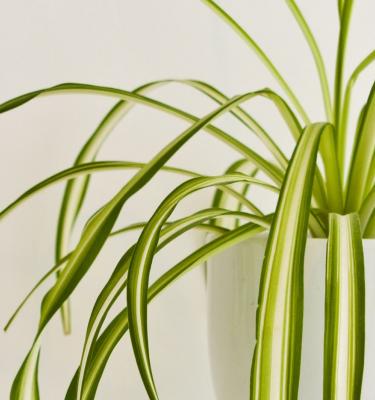

How to grow & care for Spider Plant
Spider Plants (Chlorophytum comosum) are possibly the easiest and most adaptable house plant to grow! They are happy in low to bright levels of light and will tolerate being neglected between waterings.
With long strappy green and white foliage, the Spider Plant looks best in a hanging pot or pot on a high shelf where its dramatic form can be best admired.
Top 5 steps to growing Spider Plant
- Spider Plants prefer a spot with medium to bright indirect light - direct sun can burn their leaves.
- Use a premium, like Scotts Osmocote Premium Potting Mix for Indoor Plants to give your plant the best start possible
- Spider Plants foliage looks most dramatic if you plant in a hanging basket or position the pot up high.
- Fertilise Spider Plants with an indoor plant fertiliser like Scotts Osmocote Pour+Feed for Indoor Plants once a month during spring and summer, to encourage strong healthy growth.
- Spider Plants will naturally produce little side shoots or “babies”, you can cut these from the mother plant, pot them up and you’ll have more Spider Plants!
Shopping List
- A Spider Plant plant
- A suitable pot
- Scotts Osmocote Premium Potting Mix for Indoor Plants
- Scotts Osmocote Controlled Release Fertiliser for Indoor Plants or Scotts Osmocote Pour+Feed for Indoor Plants
- A potting mix scoop
- Defender Pyrethrum Insect Spray
Growing in a pot
Choose a pot for your Spider Plant that’s roughly 2 times the size of the original nursery pot - make sure it has drainage holes or use a black plastic pot that sits snuggly inside a cover-pot or cache pot (pot with no holes).
Half-fill your pot with Scotts Osmocote Premium Potting Mix for Indoor Plants and gently remove the Spider Plant from the nursery pot and position it into the potting mix, backfill around the root ball with more potting mix so that the potting mix is level with or slightly below the top of the pot.
Water your new Spider Plant in well and tip out any excess water from the base of the coverpot or saucer (if using). Spider Plants can tolerate drying out between waterings, make sure the top 5cm of soil is dry before watering again. Don’t let water pool in the base of coverpots or in saucers as they’ll quickly rot if their potting mix remains soggy.
Fertilising & Care
Fertilise Spider Plants monthly in spring and summer with an indoor plant fertiliser to encourage new growth. Use Scotts Osmocote Pour+Feed for Indoor Plants - this is a simple-to-use ‘measure and pour’ feed that contains the right balance of nutrients. If you’d prefer a longer term fertilising product, with less applications apply Scotts Osmocote Controlled Release Fertiliser for Indoor Plants in early spring - this product feeds for up to 6 months.
In the warmer months of spring and summer Spider Plants will appreciate more regular watering, but only when the top 5cm of potting mix is dry.
To increase the humidity around Spider Plants, group them with other plants to create a microclimate or mist them with a spray bottle regularly. They don’t like being hit with dry air, so keep them away from air-conditioning or heating vents.
Remove any dead or damaged leaves to promote new growth. If the tips of the leaves go brown it could be too much sun or not enough humidity, try decreasing the amount of direct sun the plant gets and increasing the humidity around it.
WARNING - Although Spider Plants will grow outside in frost-free climates, they are considered weeds in many areas. So it’s best practice to only grow them in a pot or container, ideally indoors.
Propagating
Spider Plants propagate easily - simply cut off a baby plant from one of the side shoots. Fill a clean pot with Scotts Osmocote Premium Potting Mix and gently sit the baby Spider Plant on the surface of the potting mix. It will grow new roots very quickly!
Pests & Diseases
Look out for distorted new growth and obvious signs of pests on the undersides of leaves. Scale and mealybugs can from time to time become a problem on Spider Plants - use Defender Pyrethrum Insect Spray to control them if needed.



